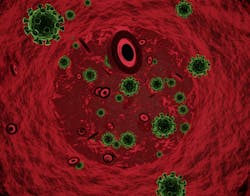Thrombosis puts someone hospitalized for COVID-19 more at risk for more problems like stroke or organ failure, while their body is already dealing with inflammation from fighting the virus, according to a news release from the University of Michigan.
“The risk of thrombosis is real, it’s important and it’s something we need to be concerned about,” says vascular cardiologist Geoffrey Barnes, MD, MSc, who sees patients at the Michigan Medicine Frankel Cardiovascular Center. He served as lead author on the Anticoagulation Forum Guidance Document.
The challenge, Barnes says, is whether, or to what extent, to change treatment approaches based on constant streams of limited data. While he’d prefer to have robust prospective data on this particular issue, clinician-scientists like Barnes instead have to rely on standards for intensive care treatment and acute respiratory distress syndrome as they sift through the flood of observational data.
Andrea Obi, MD, a Vascular Surgeon and Assistant Professor at Michigan Medicine, was lead author of a recent review that explains the observed relationship between inflammation and thrombosis in COVID-19, finding that there is a link between immune system induced inflammatory response and blood clotting in the small and large blood vessels.
Levels of D-dimer, a protein biomarker generally measured to rule out blood clots, are markedly elevated in the COVID-19 patients with severe illness, she adds. Whether these patients could benefit from receiving blood thinners to improve outcome of the disease as had been useful in other severe pandemic pneumonias remains an active area of investigation.
The National Institutes of Health recently released interim data and promoted two main takeaways: moderately sick people with COVID-19 infection did better when they took full-dose blood thinners, but the sickest patients already in intensive care for COVID-19-related illness don’t do well with the full dose.
And on the other end of the spectrum, a recent publication out of Michigan Medicine reported that patients who had worse cases of COVID-19 that required ventilator support had an imbalance in their bleeding-clotting system that increased the risk of bleeding.
“I can hypothesize why the high risk patients were harmed: they may have had more bleeding risk and a more inflammatory component of thrombosis with critical illness, but we need more data to learn about this,” Barnes says. “I continue to be hesitant about drastic clinical changes before more data from randomized clinical trials are peer-reviewed and published.”
More than 45 randomized controlled trials have been started to evaluate anticoagulation in COVID-19, he says, but in the meantime, today’s patients need the best care possible.
“I am not using VTE prophylaxis in my outpatients if they’re diagnosed with COVID-19. Rather, I’m only using it as an opportunity to reassess whether they should have been on blood thinners already, such as in the case of a patient who has a history of VTE,” Barnes says.

